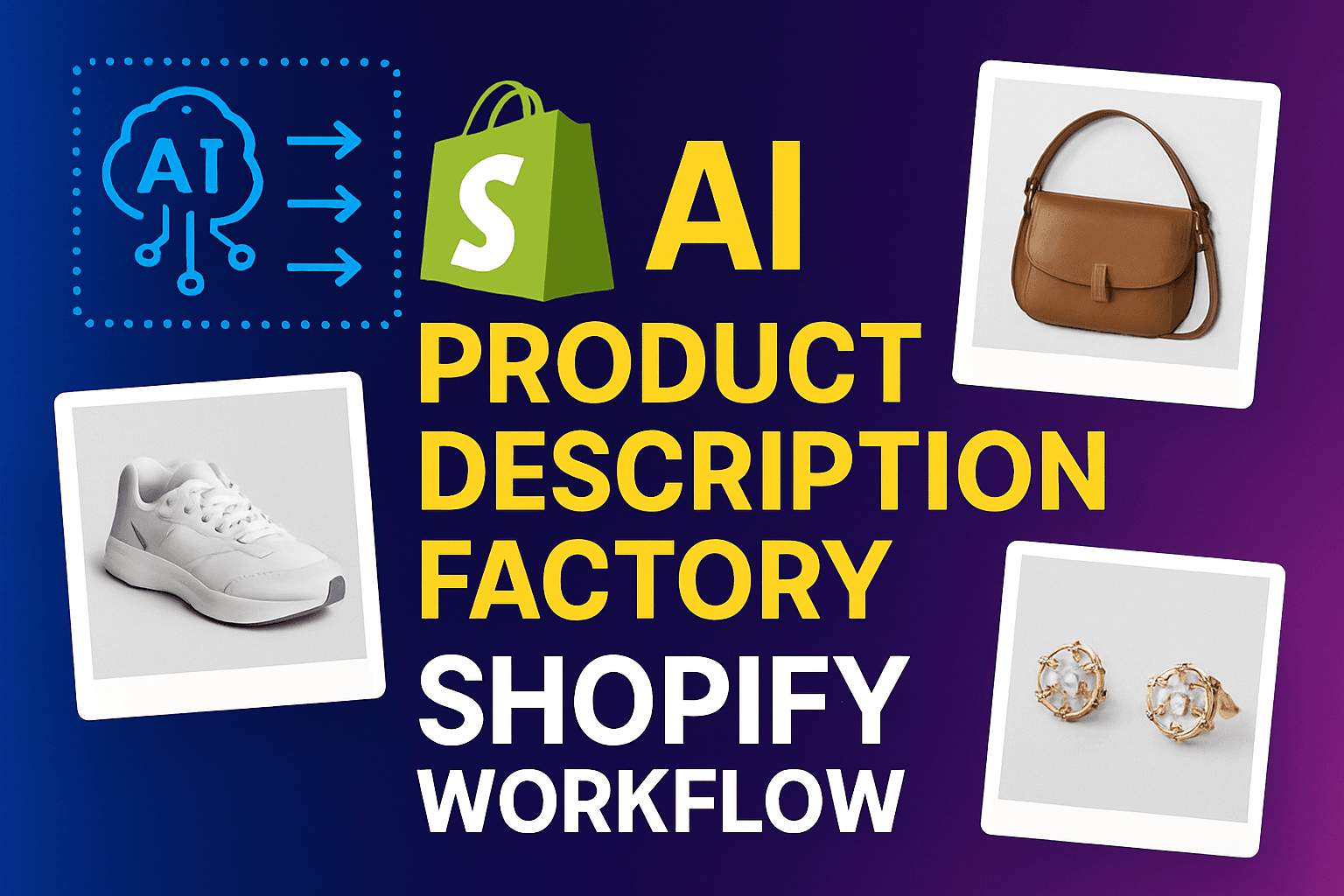Shopify AI Product Description Factory
The Shopify AI Product Description Factory is a production-grade n8n workflow that converts product images and metadata into refined, SEO-aware descriptions—fully automated and region-agnostic. It blends GPT-4o vision for visible attribute extraction, Claude 3.5 Sonnet for premium copy, Perplexity research for verified brand context, Google Sheets for orchestration and audit trails, plus automated daily sales analytics enrichment. Link-header pagination and structured output enforcement ensure reliable scale.

To refine according to your usecase connect via my profile
@connect
Key Advantages
Vision-first copywriting
Uses gpt-4o to identify only visible physical attributes (closure, heel, materials, sole) from product images—no guesses.
Premium copy generation
anthropic/claude-3.5-sonnet crafts concise, benefit-led descriptions with consistent tone, length control, and clean formatting.
Research-assisted accuracy
perplexityTool verifies vendor/brand context from official sources to avoid speculation or fabricated claims.
Pagination you can trust
Automates Shopify REST pagination via Link headers and persists page_info for resumable runs.
Google Sheets orchestration
Centralized staging, status tracking, and QA in Products, with ProcessingState for batch/page markers, and Error_log for diagnostics.
Bulletproof error feedback
errorTrigger + AI diagnosis logs clear, non-technical and technical explanations to Error_log for fast recovery.
Automated sales analytics
Daily sales tracking automatically captures and enriches total sales data for comprehensive business intelligence and performance monitoring.
How It Works
Intake and filtering
httpRequestfetches/admin/api/2024-04/products.json?limit=200&{page_info}codefilters only items with:- Image present
- Empty
body_html - The
currSeas:SS2025tag
- Extracts tag metadata such as
x-styleCode,country_of_origin, andgenderwhen available
Pagination controller
codeparses Link headers forrel="next"and extractspage_infogoogleSheetsupdates ProcessingState withpage_info_nextand increments the batch number for resumable polling
Generation pipeline
googleSheetspulls rows with Status = Ready for AI Description; limit throttles batch sizeopenAiAnalyze image (model gpt-4o) returns strictly visible featureslmChatOpenRouter(Claude 3.5) composes the SEO description, optionally blending verified vendor context fromperplexityTooloutputParserStructuredguarantees strict JSON:product_id,product_title(normalized),generated_description,statusgoogleSheetswrites results back to Products for review/publish
Sales analytics enrichment
- Schedule Trigger runs daily at 2:01 PM to capture previous day's sales
httpRequestfetches paid orders from Shopify REST API with date range filteringsplitOutandsummarizenodes calculate total daily sales- Automatic Google Sheets logging with date stamps and totals
- Zero-sale days are properly recorded for complete analytics continuity
Reliability and insight
errorTrigger routes failures to an AI agent that explains the root cause and appends a concise note to Error_log.
What's Inside (Node Map)
Data + API
httpRequest(Shopify REST 2024-04 for products and orders)googleSheets(multiple sheet operations)googleSheetsTool(error logging)
AI models
openAi(gpt-4o vision analysis)lmChatOpenRouter(anthropic/claude-3.5-sonnet for content generation)- AI Agent (intelligent error diagnosis)
Analytics & Processing
splitOut(order data processing)summarize(sales totals calculation)setnodes (data field mapping)
Tools and guards
perplexityTool(brand research)outputParserStructured(JSON validation)memoryBufferWindow(conversation context)
Control & Scheduling
scheduleTrigger(multiple time-based triggers)cron(periodic execution)limit(batch size control)if(conditional logic)code(custom filtering and pagination logic)
Observability
errorTrigger+ AI diagnosis to Error_log- Processing state tracking
- Sales analytics logging
Content & Compliance Rules
- Locale-agnostic copy; brand voice is configurable per store
- Only image-verifiable attributes (no guesses); clean HTML suitable for Shopify themes
- Optional normalization rules (e.g., color/branding cleanup, title sanitization)
- Style code inclusion supported when
x-styleCodeis present - Gender-aware content generation when
gendertag is present - Strict JSON output and schema consistency for safe downstream publishing
Setup Steps
Core integrations
- Shopify Access Token — Products read + Orders read (REST 2024-04)
- OpenAI API — gpt-4o vision
- OpenRouter API — Claude Sonnet (3.5)
- Perplexity API — vendor/market verification via perplexityTool
- Google Sheets OAuth — Products, ProcessingState, Error_log, Sales analytics
Configure sheets
- ProcessingState with fields:
- batch number
page_info_next
- Products with:
- Product ID
- Product Title
- Product Type
- Vendor
- Image url
- Status
- country of origin
- x_style_code
- gender
- Generated Description
- Error_log with:
- timestamp
- Reason of Error
- Sales Analytics Sheet with:
- Date
- Total Sales
Workflow Capabilities
Discovery and staging
Auto-paginate Shopify; stage eligible products in Sheets with reasons and timestamps.
Vision-grounded copywriting
Descriptions reflect only visible attributes plus verified brand context; concise, mobile-friendly structure with gender-aware tone.
Metadata awareness
Auto-injects x-styleCode, country_of_origin, and gender when present; natural SEO for brand and product type.
Sales intelligence
Automated daily sales tracking with Melbourne timezone support, handles zero-sale days, and maintains complete historical records.
Error analytics
Layman + technical diagnosis logged to Error_log to shorten MTTR.
Safe output
Structured JSON via outputParserStructured for predictable row updates.
Credentials Required
- Shopify Access Token (Products + Orders read permissions)
- OpenAI API Key (GPT-4o vision)
- OpenRouter API Key (Claude Sonnet)
- Perplexity API Key
- Google Sheets OAuth
Ideal For
- E-commerce teams scaling compliant, on-brand product copy with comprehensive sales insights
- Agencies and SEO specialists standardizing image-grounded descriptions with performance tracking and analytics
- Stores needing resumable pagination, auditable content operations, and automated daily sales reporting in Sheets
Advanced Features
- Dual-workflow architecture: Content generation + Sales analytics in one system
- Link-header pagination with
page_infopersistence in ProcessingState - Title/content normalization (e.g., color removal) configurable per brand
- Gender-aware copywriting based on product tags
- Memory windows (
memoryBufferWindow) to keep multi-step prompts consistent - Melbourne timezone support for accurate daily sales cutoffs
- Zero-sales handling ensures complete analytics continuity
- Structured Output enforcement for downstream safety
- AI-powered error diagnosis with technical and layman explanations
Time & Scheduling (Universal)
The workflow includes two independent schedules:
- Content Generation: Every 5 minutes (configurable) for product processing
- Sales Analytics: Daily at 2:01 PM Melbourne time for previous day's sales
For globally distributed teams, schedule triggers and timestamps can be standardized on UTC to avoid regional drift.
Pro Tip
Start with small batches (limit set to 10 or fewer) to validate both copy generation and sales tracking flows. The workflow handles dual operations independently - content generation failures won't affect sales analytics and vice versa. Monitor the Error_log sheet for any issues and use the ProcessingState sheet to track pagination progress.